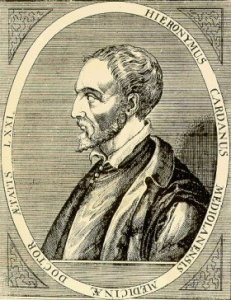The story of the discovery of the solution formula for cubic equations is stunning.
What happened gives us an interesting view of renaissance mathematics and shows us what it meant to be a mathematician in the 15th and 16th centuries.
In those days, mathematicians were used to publicly challenging each other in mathematical duels. Each one would submit to the other a fixed number of problems. The one who could solve more problems won the challenge, gaining exposure, and with it, the chance of being hired by a patron.
For that reason it was common for mathematicians to keep their discoveries secret with the purpose of using them to create problems their rival wouldn’t be able to solve.
The Story Begins
The first to shed light on the problem of finding the solution of the cubic equation
$$ax^3+bx^2+cx+d=0$$
was the Italian mathematician Scipione del Ferro, born in 1465 in Bologna where his father worked in the paper industry. Perhaps his father’s work gave del Ferro access to books that would otherwise not have been easy to find.
Around 1505, he found the solution to the so-called depressed cubic, the equation of the form
$$x^3+px=q$$
that is a cubic in which the quadratic term doesn’t appear. He probably used his discovery to win mathematical challenges and gain money and reputation, but he never published his result. Just before dying in 1526 he revealed the secret to his student, Antonio Del Fiore, who began to publicly congratulate himself for being able to solve that kind of problem.
A Rival Comes Forward
In 1530 another mathematician, Niccolò Fontana, found the solution to another kind of cubic equation, the one without the linear term.

When Niccolò was 12, a French soldier struck him with a sword during the invasion of the city of Brescia by King Luis XII’s troops. Niccolò appeared dead and the soldier didn’t insist on making sure. In fact, he was still alive, but the wounds he received caused him speaking difficulties for the rest of his life. For that reason he was nicknamed tartaglia, which means “stammerer.”
Del Fiore thought Fontana was bluffing about his discovery and challenged him. Fontana instead guessed his rival could really solve depressed cubic equations and with a huge effort succeeded in independently discovering the same solution just before the challenge.
Fontana solved two different kinds of cubic equations and won the match hands down. He was able to solve all 30 problems Del Fiore submitted to him, while Del Fiore could not solve any.
It was 1535 and, as you can guess, Fontana didn’t publish his discoveries.
Things Get Complicated
In 1539 the mathematician Gerolamo Cardano invited Fontana to Milan and convinced him to reveal the solution to the depressed cubic. Fontana, maybe hoping to gain a position as a professor in Milan, unveiled his discovery to Cardano making him take an oath not to divulge it.

After some time Cardano found a way to reduce every cubic equation into a depressed cubic, solving the problem of finding the general solution. Nevertheless his discovery was connected to Fontana’s result and he couldn’t publish anything due to the promise he’d made.
Rumors that Del Ferro had previously found the solution to the depressed cubic reached Cardano who succeed in finding a manuscript in which Del Ferro had written his results. Due to this discovery, Cardano felt that he was no longer obliged to keep the secret. In 1545 he published the results giving credit to Fontana and Del Ferro for the discovery of the solution to the depressed cubic.
Fontana was upset about this and began a dispute with Cardano that resulted in a challenge between Fontana and Cardano’s student, Ludovico Ferrari.
The challenge was held in Milan and rules were fixed as to favor the home competitor, Ferrari. Part of the challenge was verbal so that Fontana was at a disadvantage due to his speech difficulties. Ferrari prevailed, and as a consequence, Fontana lost his academic position in Brescia and had financial problems for the rest of his life.
The work by Cardano and Ferrari on cubic and quartic equations was a huge breakthrough and laid the foundations for subsequent discoveries, in particular concerning the nature of imaginary numbers. As a matter of fact, imaginary numbers sometimes come up in the solution formula for cubic equations, even when the solution is real.
But that, as we usually say, is another story.


